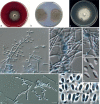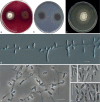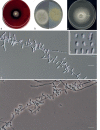Phylogeny of chrysosporia infecting reptiles: proposal of the new family Nannizziopsiaceae and five new species
- PMID: 24761037
- PMCID: PMC3904055
- DOI: 10.3767/003158513X669698
Phylogeny of chrysosporia infecting reptiles: proposal of the new family Nannizziopsiaceae and five new species
Abstract
We have performed a phenotypic and phylogenetic study of a set of fungi, mostly of veterinary origin, morphologically similar to the Chrysosporium asexual morph of Nannizziopsis vriesii (Onygenales, Eurotiomycetidae, Eurotiomycetes, Ascomycota). The analysis of sequences of the D1-D2 domains of the 28S rDNA, including representatives of the different families of the Onygenales, revealed that N. vriesii and relatives form a distinct lineage within that order, which is proposed as the new family Nannizziopsiaceae. The members of this family show the particular characteristic of causing skin infections in reptiles and producing hyaline, thin- and smooth-walled, small, mostly sessile 1-celled conidia and colonies with a pungent skunk-like odour. The phenotypic and multigene study results, based on ribosomal ITS region, actin and β-tubulin sequences, demonstrated that some of the fungi included in this study were different from the known species of Nannizziopsis and Chrysosporium and are described here as new. They are N. chlamydospora, N. draconii, N. arthrosporioides, N. pluriseptata and Chrysosporium longisporum. Nannizziopsis chlamydospora is distinguished by producing chlamydospores and by its ability to grow at 5 °C. Nannizziopsis draconii is able to grow on bromocresol purple-milk solids-glucose (BCP-MS-G) agar alkalinizing the medium, is resistant to 0.2 % cycloheximide but does not grow on Sabouraud dextrose agar (SDA) with 3 % NaCl. Nannizziopsis arthrosporioides is characterised by the production of very long arthroconidia. Nannizziopsis pluriseptata produces 1- to 5-celled sessile conidia, alkalinizes the BCP-MS-G agar and grows on SDA supplemented with 5 % NaCl. Chrysosporium longisporum shows long sessile conidia (up to 13 μm) and does not produce lipase.
Keywords: Chrysosporium; Nannizziopsiaceae; Nannizziopsis; Onygenales; animal infections; ascomycetes; mycoses; reptiles.
Figures










References
-
- Abarca ML, Castellá G, Martorell J, Cabañes FJ. 2010. Chrysosporium guarroi sp. nov. a new emerging pathogen of pet green iguanas (Iguana iguana). Medical Mycology 48: 365–372 - PubMed
-
- Abarca ML, Martorell J, Castellá G, Ramis A, Cabañes FJ. 2008. Cutaneous hyalohyphomycosis caused by a Chrysosporium species related to Nannizziopsis vriesii in two green iguanas (Iguana iguana). Medical Mycology 46: 349–354 - PubMed
-
- Abarca ML, Martorell J, Castellá G, Ramis A, Cabañes FJ. 2009. Dermatomycosis in a pet inland bearded dragon (Pogona vitticeps) caused by a Chrysosporium species related to Nannizziopsis vriesii. Veterinary Dermatology 20: 295–299 - PubMed
-
- Abdel-Razik M, Zaki SM. 2008. Experimental pathogenicity and molecular characterization of an environmental isolate of Chrysosporium zonatum Al-Musallam and Tan (Family: Onygenaceae, Order: Onygenales). International Journal of Agriculture and Biology 10: 273–277
LinkOut - more resources
Full Text Sources
Other Literature Sources
Molecular Biology Databases
